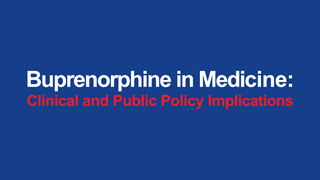Appendix: Impact of the extended-release/long-acting opioid analgesics risk evaluation and mitigation strategy on prescribing practices - Appendix
DOI:
https://doi.org/10.5055/jom.2023.0764-AppendixKeywords:
continuing education, extended-release, long-acting, opioid, opioid abuse, risk evaluation and mitigation strategyAbstract
Objective: To assess the impact of extended-release (ER)/long-acting (LA) opioid prescriber training on prescribing behaviors.
Design: Retrospective cohort study.
Setting: Prescriber training was evaluated from June 1, 2013 through December 31, 2016. The full study period was 2 years longer, from June 1, 2012 through December 31, 2017, to include data for all prescribers’ 1-year pretraining and post-training periods.
Participants: 24,428 prescribers who wrote ER/LA opioid prescriptions for eligible patients, with a record of training from the partner continuing education provider between June 1, 2013 and December 31, 2016.
Intervention: ER/LA opioid prescriber training. Main outcome measures: Prescribing behaviors 1-year before (pretraining) and after (post-training) prescribers completed training, specifically the proportion of opioid-nontolerant patients receiving ER/LA opioids indicated for opioid-tolerant patients and for patients receiving ≥100 morphine equivalents dose daily, and the proportion of concomitant users of central nervous system depressant drugs.
Results: The differences in the proportion of opioid-nontolerant patients receiving ER/LA opioids indicated for opioid-tolerant patients and for patients receiving ≥100 morphine equivalents dose daily were –0.69 percent (95 percent confidence interval [CI]: –1.78 percent, 0.40 percent) and –0.23 percent (95 percent CI: –1.18 percent, 0.68 percent), respectively. The differences in the proportion of concomitant users of central nervous system depressant drugs were –0.94 percent (95 percent CI: –1.39 percent; –0.48 percent) for benzodiazepines, 0.06 percent (95 percent CI: –0.13 percent; 0.25 percent) for antipsychotics, –0.41 percent (95 percent CI: –0.69 percent; –0.13 percent) for hypnotics/sedatives, and 0.08 percent (95 percent CI: –0.40 percent; 0.57 percent) for muscle relaxants.
Conclusions: While prescribers showed some changes in prescribing behavior after completing training, training was not associated with clinically relevant changes in prescribing behaviors.
References
Guy JG, Zhang K, Bohm MK, et al.: Vital signs: Changes in opioid prescribing in the United States, 2006-2015. MMWR Morb Mortal Wkly Rep. 2017; 66(26): 697-704.
Jones CM, Mack KA, Paulozzi LJ: Pharmaceutical overdose deaths, United States, 2010. JAMA. 2013; 309(7): 657-659.
Okie S: A flood of opioids, a rising tide of deaths. N Engl J Med. 2010; 363(21): 1981-1985.
United States Food and Drug Administration: Risk evaluation and mitigation strategy (REMS) for opioid analgesics. Available at http://er-la-opioidrems.com/IwgUI/rems/home.action. Accessed July 25, 2018.
United States Food and Drug Administration: FDA takes important steps to encourage appropriate and rational prescribing of opioids through final approval of new safety measures governing the use of immediate-release opioid analgesic medications. Available at https://www.fda.gov/NewsEvents/Newsroom/PressAnnouncements/ucm620935.htm. Accessed January 17, 2019.
United States Food and Drug Administration: Introduction for the FDA blueprint for prescriber education for extended-release and long-acting opioid analgesics. Available at https://www.fda.gov/downloads/Drugs/DrugSafety/InformationbyDrugClass/UCM515636.pdf. Accessed July 25, 2018.
United States Food and Drug Administration: Prescriber letter #3: FDA-required REMS program for serious drug risks. Available at https://www.accessdata.fda.gov/drugsatfda_docs/rems/ERLA_2017-05-26_Prescriber_Letter_3.pdf. Accessed August 8, 2018.
Bucher Bartelson B, Le Lait MC, Green JL, et al.: Changes in misuse and abuse of prescription opioids following implementation of extended-release and long-acting opioid analgesic risk evaluation and mitigation strategy. Pharmacoepidemiol Drug Saf. 2017; 26(9): 1061-1070.
Cepeda MS, Coplan PM, Kopper NW, et al.: ER/LA opioid analgesics REMS: Overview of ongoing assessments of its progress and its impact on health outcomes. Pain Med. 2017; 18(1): 78-85.
Esposito D, Desai V, Cepeda MS, et al.: Incidence of opioid overdose and death among patients using ER/LA opioid analgesics before and after implementation of the class-wide REMS. Presented at: American Academy of Pain Medicine Annual Meeting, March 16-19, 2017, Orlando, FL.
Divino V, Cepeda MS, Coplan P, et al.: Assessing the impact of the extended-release/long-acting opioid analgesics risk evaluation and mitigation strategies on opioid prescription volume. J Opioid Manag. 2017; 13(3): 157-168.
Reifler LM, Droz D, Bailey JE, et al.: Do prescription monitoring programs impact state trends in opioid abuse/misuse? Pain Med. 2012; 13(3): 434-442.
Centers for Disease Control and Prevention: State prescription drug laws. Available at www.cdc.gov/drugoverdose/policy/laws.html. Accessed April 24, 2017.
Bureau of Justice Assistance: Program performance report, prescription drug monitoring program. Available at https://www.bja.gov/Publications/PDMP_PPR_Jan-Dec13.pdf. Accessed April 24, 2014.
Mercer Inc: State Medicaid interventions for preventing prescription drug abuse and overdose: A report for the national association of Medicaid directors. Available at http://medicaiddirectors.org/publications/state-medicaid-interventions-for-preventing-prescription-drug-abuse-and-overdose/. Accessed April 24, 2017.
United States Department of Health and Human Services: Prevention programs & tools. Available at https://www.hhs.gov/opioids/prevention/prevention-programs-tools/index.html. Accessed February 25, 2019.
Davis CS, Carr D: Physician continuing education to reduce opioid misuse, abuse, and overdose: Many opportunities, few requirements. Drug Alcohol Depend. 2016; 163: 100-107.
Accreditation Council for Continuing Medical Education: The ACCME accreditation requirements. Available at https://www.accme.org/sites/default/files/2019-01/626_20190125_Accreditation_Requirements_Document.pdf. Accessed March 25, 2019.
Olfson M, King M, Schoenbaum M: Benzodiazepine use in the United States. JAMA Psychiatry. 2015; 72(2): 136-142.
Olfson M, King M, Schoenbaum M: Treatment of young people with antipsychotic medications in the United States. JAMA Psychiatry. 2015; 72(9): 867-874.
King M, Essick C: The geography of antidepressant, antipsychotic, and stimulant utilization in the United States. Health Place. 2013; 20: 32-38.
Schumock GT, Stayner LT, Valuck RJ, et al.: Risk of suicide attempt in asthmatic children and young adults prescribed leukotriene-modifying agents: A nested case-control study. J Allergy Clin Immunol. 2012; 130(2): 368-375.
Greenland S, Rothman KJ, Lash TL: Introduction to stratified analysis. In Seigafuse S, Bierig L (eds.): Modern Epidemiology. Philadelphia, PA: Lippincott Williams & Wilkins, 2008: 258-282.
Balding D, Cressie N, Fitzmaurice G, et al. (eds.): Introduction to Categorical Data Analysis. Hoboken, NJ: John Wiley & Sons, Inc., 2018.
United States Census Bureau: Census regions and divisions of the United States. Available at http://www2.census.gov/geo/pdfs/maps-data/maps/reference/us_regdiv.pdf. Accessed February 26, 2019.
Heyward J, Olson L, Sharfstein JM, et al.: Evaluation of the extended-release/long-acting opioid prescribing risk evaluation and mitigation strategy program by the US food and drug administration: A review. JAMA Intern Med. 2020; 180(2): 301-309.
Dowell D, Haegerich TM, Chou R: CDC guideline for prescribing opioids for chronic pain—United States, 2016. JAMA. 2016; 315(15): 1624-1645.
Alford DP, Zisblatt L, Ng P, et al.: SCOPE of pain: An evaluation of an opioid risk evaluation and mitigation strategy continuing education program. Pain Med. 2016; 17(1): 52-63.
Chatterjee P, Finnegan T, Grimes C, et al.: Interim analysis of practice changes following participation in online and live ER/LA opioid CME/CE programs from the CO*RE collaborative (P1. 221). Presented at: American Academy of Neurology, April 22-28, 2017, Boston, MA.
Cervero RM: Effectiveness of continuing medical education: Updated synthesis of systematic reviews. Available at https://www.accme.org/sites/default/files/652_20141104_Effectiveness_of_Continuing_Medical_Education_Cervero_and_Gaines.pdf. Accessed December 7, 2022.
Mansouri M, Lockyer J: A meta-analysis of continuing medical education effectiveness. J Contin Educ Health Prof. 2007; 27(1): 6-15.
Bloom BS: Effects of continuing medical education on improving physician clinical care and patient health: A review of systematic reviews. Int J Technol Assess Health Care. 2005; 21(3): 380-385.
Marinopoulos SS, Dorman T, Ratanawongsa N, et al.: Effectiveness of continuing medical education. Evid Rep Technol Assess (Full Rep). 2007; 149(1): 1-69.
Murad MH, Coto-Yglesias F, Varkey P, et al.: The effectiveness of self-directed learning in health professions education: A systematic review. Med Educ. 2010; 44(11): 1057-1068.
Duensing K, Twillman R, Ziegler S, et al.: An examination of state and federal opioid analgesic and continuing education policies: 2016–2018. JPR. 2020; 13: 2431-2442.
Published
How to Cite
Issue
Section
License
Copyright 2005-2024, Weston Medical Publishing, LLC
All Rights Reserved













